1993 CHEVROLET CAMARO stop start
[x] Cancel search: stop startPage 62 of 358
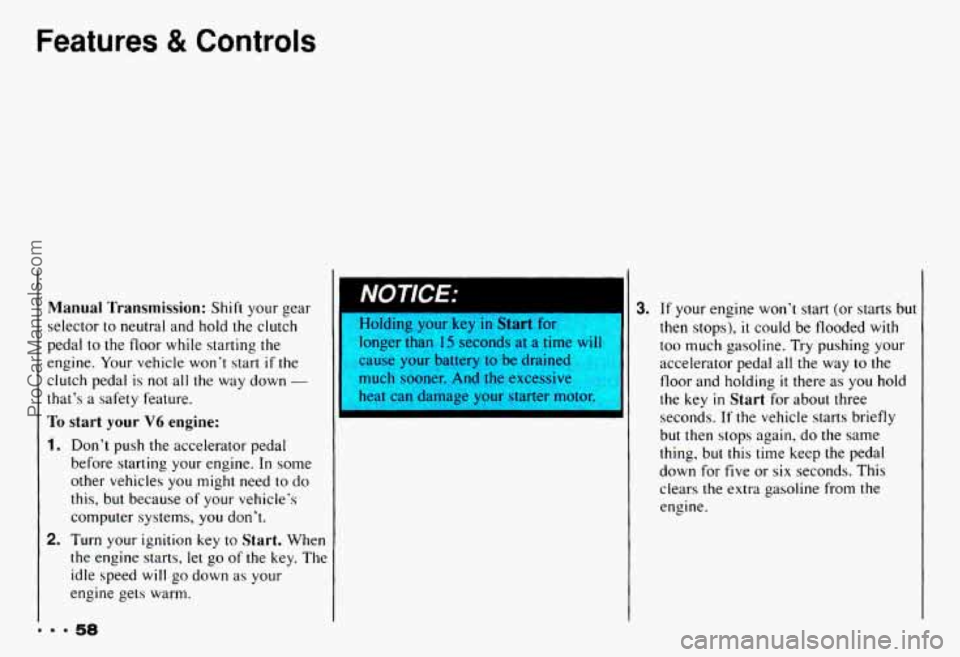
Features & Controls
Manual Transmission: Shift your gear
selector to neutral and hold the clutch
pedal
to the floor while starting the
engine. Your vehicle won’t start if the
clutch pedal
is not all the way down -
that’s a safety feature.
To start your V6 engine:
1. Don’t push the accelerator pedal
before starting your engine.
In some
other vehicles
you might need to do
this, but because of your vehicle’s
computer systems,
you don’t.
2. Turn your ignition key
to Start. When
the engine starts, let go
of the key. The
idle speed
will go down as your
engine gets warm.
NOTICE: 3. If your engine won’t start (or starts but
then stops),
it could be flooded with
too much gasoline. Try pushing your
accelerator pedal all the way
to the
floor and holding
it there as you hold
the
key in Start for about three
seconds.
If the vehicle starts briefly
but then stops again, do the same
thing, but
this time keep the pedal
down for five
or six seconds. This
clears the extra gasoline from the engine.
ProCarManuals.com
Page 64 of 358
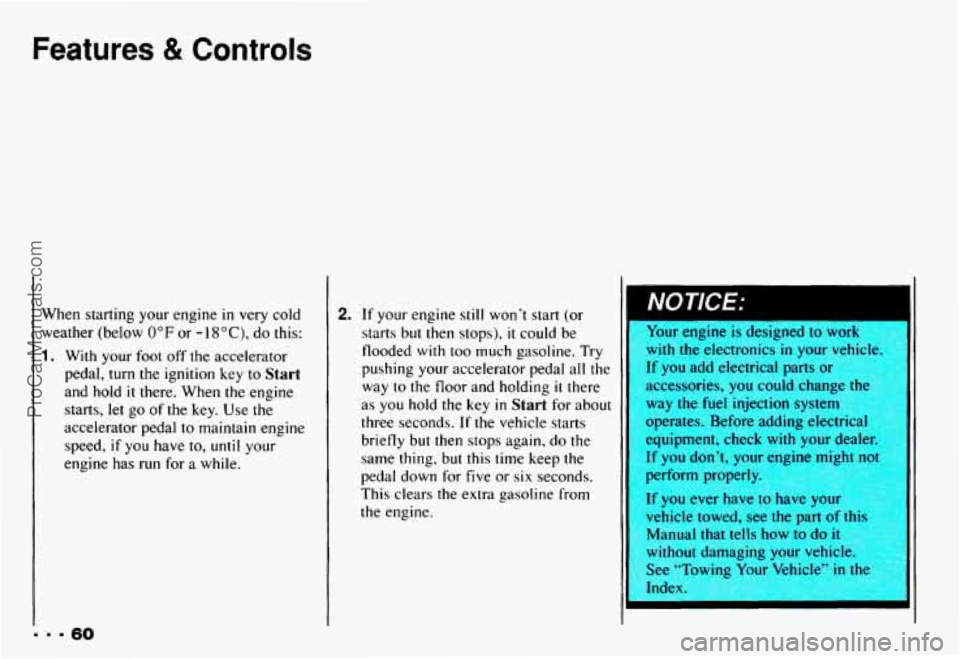
Features 8t Controls
When starting your engine in very cold
weather (below
0°F or - I SOC), do this:
1. With your foot off the accelerator
pedal,
turn the ignition key to Start
and hold it there. When the engine
starts, let go of the key. Use the
accelerator pedal to maintain engine
speed,
if you have to, until your
engine has run for
a while.
2. If your engine still won’t start (or
starts
but then stops), it could be
flooded
with too much gasoline. Try
pushing your accelerator pedal all the
way to the floor and holding
it there
as you hold the key in Start for about
three seconds.
If the vehicle starts
briefly but then stops again, do the
same thing, but this time keep the
pedal down for five or
six seconds.
This clears the extra gasoline from
the engine.
NOTICE:
1 Your engine is designed to work
with the electronics in your vehicle.
If you add electrical parts or
accessories, you could change
th
way the fuel injection system
operates. Before adding electrlcal
equipment, check with your dealer.
II
If you don’t, your engine might not
perform properly.
If you ever have
to have your
vehicle towed, see the part
of thi
Manual that tells how to do it
without damaging your vehicle.
See “Towing Your Vehicle’’
in th
Index
I I
ProCarManuals.com
Page 67 of 358

I
Ensure the shift lever is fully in P (Park)
range before starting the engine. Your
Chevrolet has a brake-transmission shift
interlock. You have
to fully apply your
regular brakes
before you can shift from
P (Park) when the ignition key is in the
0 R (Reverse)
Use this gear to back up.
11 NOTICE:
I Shifting to K (Reverse) while your
Run position. If you cannot shift out of vehicle is moving forward could
P (Park), ease pressure on the shift lever damage your transmission. Shift to
- push the shift lever all the way into R only after your vehicle is stopped.
P (Park) and also release the shift lever
button on floor shift console models as
you maintain brake application. Then
move the shift lever into the gear you
wish. (Press the shift lever button before
moving
the shift lever on tloor shift
console models.) See "Shifting out of
P (Park)" in this part.
To rock your vehicle back and forth to
damaging your transmission, see "Stuck:
In Sand, Mud, Ice or Snow, If You're"
in the Index.
L get out of snow, ice or sand without
N (Neutral)
In this position, your engine doesn't
connect
with the wheels. To restart when
you're already moving, use
N (Neutral)
only.
Also, use N when your vehicle is
being towed.
639 9
ProCarManuals.com
Page 71 of 358
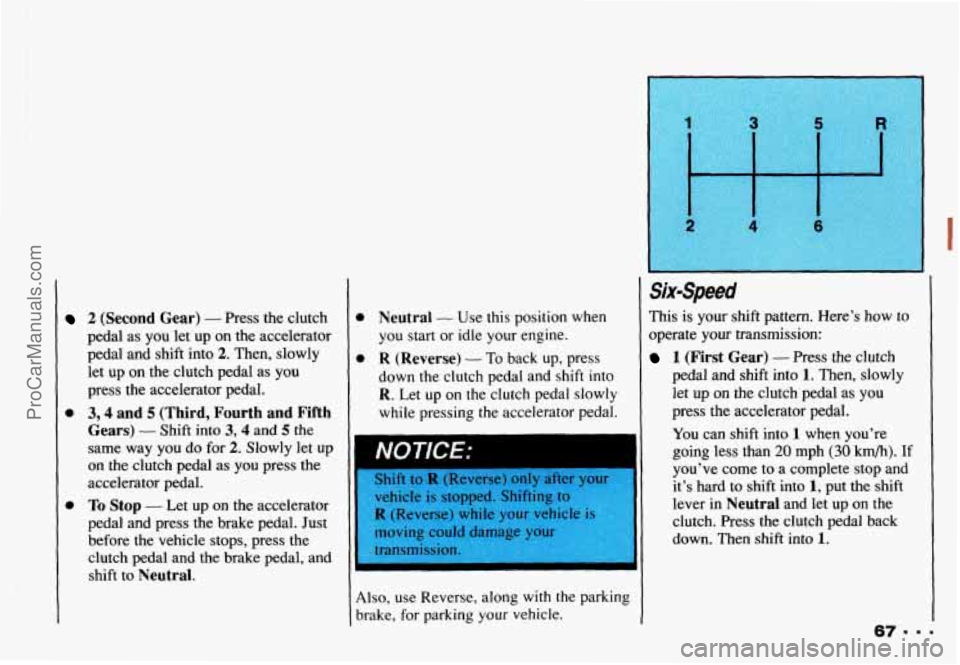
0
2 (Second Gear) - Press the clutch
pedal as you let up on the accelerator
pedal and shift into
2. Then, slowly
let up
on the clutch pedal as you
press
the accelerator pedal.
3,4 and 5 (Third, Fourth and Fifth
Gears)
- Shift into 3,4 and 5 the
same way
you do for 2. Slowly let up
on the clutch pedal as you press the
accelerator pedal.
To Stop - Let up on the accelerator
pedal and press the brake pedal. Just
before the vehicle stops, press the
clutch pedal and the brake pedal, and
shift to
Neutral.
0
0 Neutral - Use this position when
you start or idle your engine.
R (Reverse) - To back up, press
down the clutch pedal and shift into
R. Let up on the clutch pedal slowly
while pressing the accelerator pedal.
m-
- ~~
NOTICE:
Shift to K (Reverse) only atter your
vehicle is stopped. Shifting to
R (Reverse) while your vehicl
moving could darnage-pur
transmission. .I :.: , .. , LC.; 96’ b~ ,.? * ., )I
Also, use Reverse, along with the parking
brake, for parking your vehicle.
Six-Speed
This is your shift pattern. Here’s how to
operate your transmission:
1 (First Gear) - Press the clutch
pedal and shift into
1. Then, slowly
let up on the clutch pedal as you
press the accelerator pedal.
You can shift into 1 when you’re
going less than
20 mph (30 km/h). If
you’ve come to a complete stop and
it’s hard to shift into
1, put the shift
lever in
Neutral and let up on the
clutch. Press the clutch pedal back
down. Then shift into
1.
I
ProCarManuals.com
Page 72 of 358
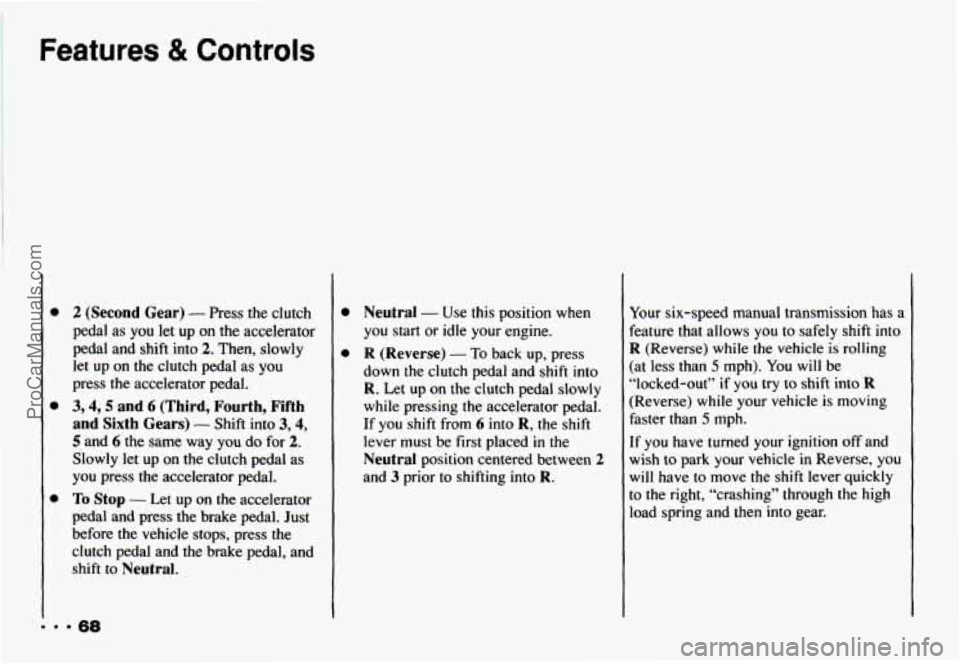
Features & Controls
0
0
0
2 (Second Gear) - Press the clutch
pedal as you let up on the accelerator
pedal and shift into
2. Then, slowly
let up on the clutch pedal as you
press the accelerator pedal.
3,4,S and 6 (Third, Fourth, Fifth
and Sixth Gears)
- Shift into 3,4,
5 and 6 the same way you do for 2.
Slowly let up on the clutch pedal as
you press the accelerator pedal.
To Stop - Let up on the accelerator
pedal and press
the brake pedal. Just
before the vehicle stops, press the
clutch pedal and the brake pedal, and
shift to
Neutral. Neutral
- Use this position when
you start or idle your
engine.
R (Reverse) - To back up, press
down the clutch pedal and shift into
R. Let up on the clutch pedal slowly
while pressing the accelerator pedal.
If
you shift from 6 into R, the shift
lever must be first placed
in the
Neutral position centered between 2
and 3 prior to shifting into R.
Your six-speed manual transmission has a
feature that allows you to safely shift into
R (Reverse) while the vehicle is rolling
(at less than
5 mph). You will be
“locked-out”
if you try to shift into R
(Reverse) while your vehicle is moving
faster than
5 mph.
If
you have turned your ignition off and
wish to park your vehicle
in Reverse, you
will have to move the shift lever quickly
to the right, “crashing” through the high
load spring and then into gear.
ProCarManuals.com
Page 82 of 358
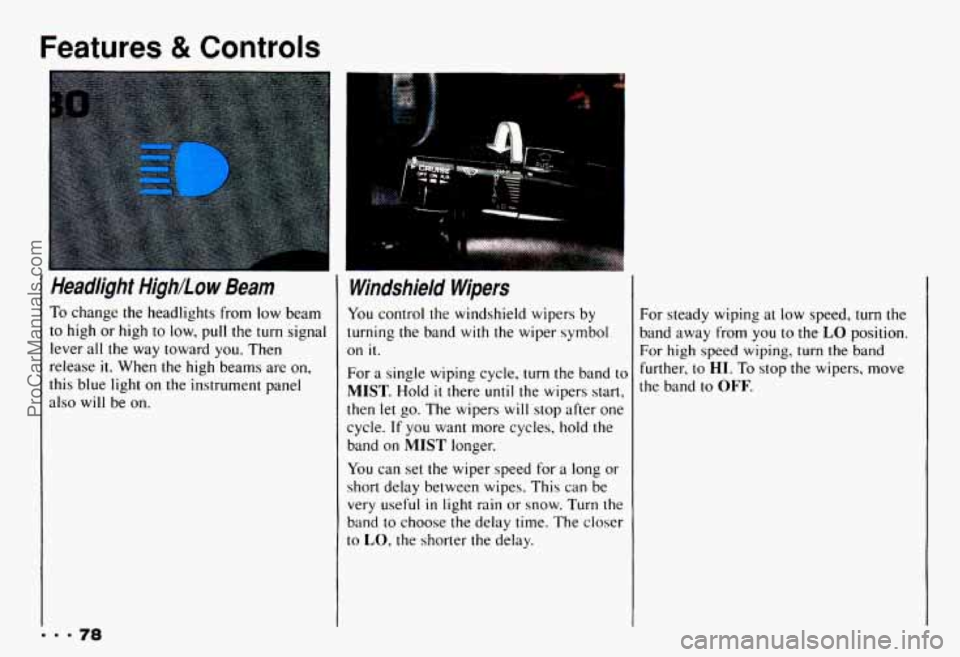
Features & Controls
Headlight HighLow Beam
To change the headlights from low beam
to high or high
to low, pull the turn signal
lever all
the way toward you. Then
release
it. When the high beams are on,
this blue light on the instrument panel
also will
be on.
. e*. 5 r
Windsmpers
You control the windshield wipers by
turning the band with the wiper symbol
on it.
For a single wiping cycle, turn the band
to
MIST. Hold it there until the wipers start,
then let go. The wipers
will stop after one
cycle.
If you want more cycles, hold the
band on
MIST longer.
You can set the wiper speed for a long or
short delay between wipes. This can be
very useful
in light rain or snow. Turn the
band to choose the delay time. The closer
to LO, the shorter the delay. For
steady wiping at
low speed, turn the
band away from you
to the LO position.
For high speed wiping, turn the band
further,
to HI. To stop the wipers, move
the band
to OFF.
99978
ProCarManuals.com
Page 104 of 358
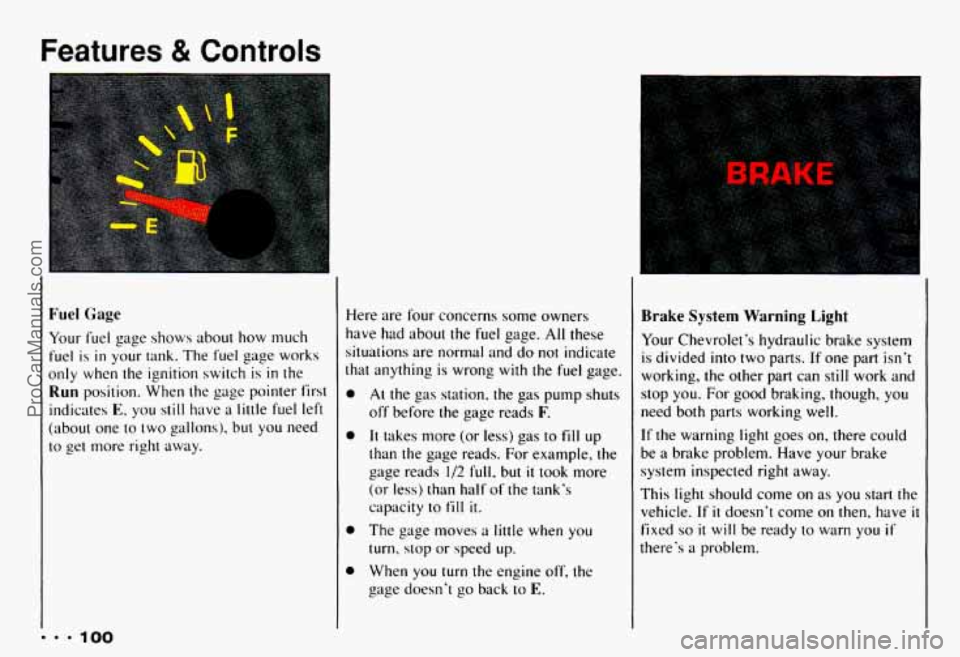
Features & Controls
Fuel Gage
... 100
Your fuel page shows about how much
fuel
is in your tank. The fuel gage works
only when the ignition switch is
in the
Run position. When the gage pointer first
indicates
E, you still have a little fuel left
(about one to two gallons),
but you need
to get more right away. Here
are four concerns some owners
have had about the fuel gage.
All these
e
situations are normal and do not indicate
that anything
is wrong with the fuel gage.
e
0
0
At the gas station, the gas pump shuts
off before the gage reads
F.
It takes more (or less) gas to fill up
than the gage reads. For example, the
gage reads
1/2 full, but it took more
(or
less) than half of the tank's
capacity
to fill it.
The gage moves a little when you
turn, stop or speed up.
When you
turn the engine off, the
c gage doesn't go back to E.
Brake System Warning Light
Your Chevrolet's hydraulic brake system
is divided into two parts. If one part isn't
working, the other part can still work and
stop you. For good braking, though, you
need both parts working well.
If the warning light goes on, there could
be a brake problem. Have your brake
system inspected right away.
This light should come on as you start the
vehicle.
If it doesn't come on then, have it
fixed so it will be ready to warn you if
there's a problem.
ProCarManuals.com
Page 105 of 358
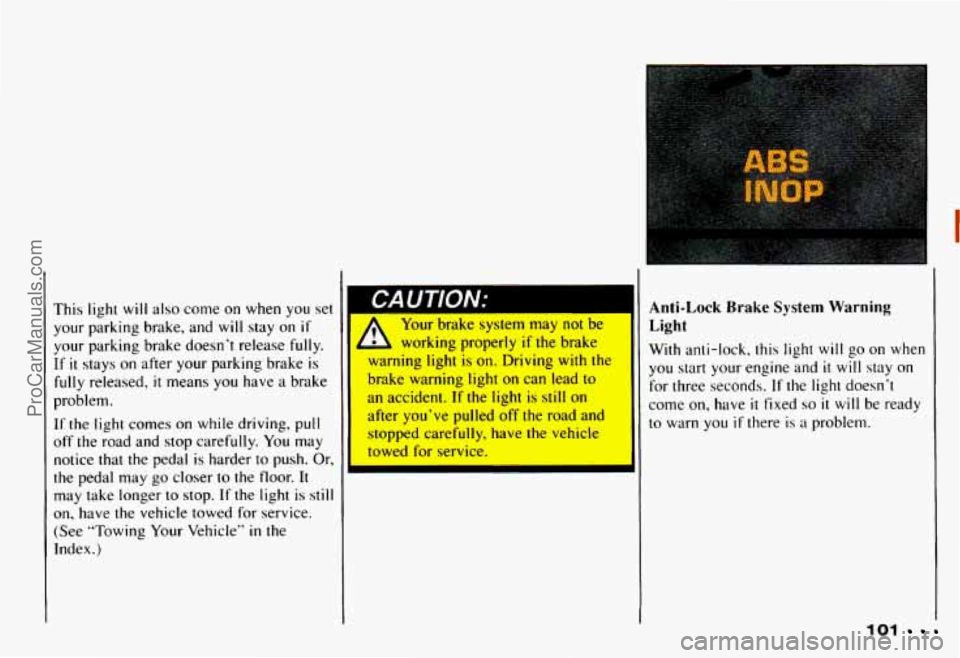
I
This light will also come on when you set
your parking brake, and will stay on
if
your parking brake doesn’t release fully.
If it stays on after your parking brake is
fully released, it means you have a brake
problem.
If the light comes on while driving, pull
off the road and stop carefully. You may
notice that the pedal is harder to push. Or,
the pedal may
go closer to the floor. It
may take longer to stop.
If the light is still
on, have the vehicle towed for service.
(See “Towing Your Vehicle”
in the
Index.)
I
CAUTION: II ____~
Your brake system may not be
working properly if the brake
warning light is on. Driving
with the
brake warning light on can lead to
an accident. If the light is still
on
after you’ve pulled off the road and
stopped carefully, have the vehicle
towed for service.
I
Anti-Lock Brake System Warning
Light
With anti-lock, this light will go on when
you start your engine and
it will stay on
for three seconds.
If the light doesn‘t
come
on, have it fixed so it will be ready
to warn
you if there is a problem.
101
ProCarManuals.com